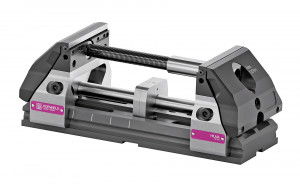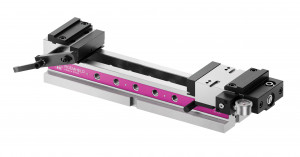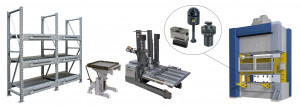Universal machine vice is highly repeatable
For the first time at a major UK exhibition, Roemheld will demonstrate its recently introduced, mechanically operated, centric (self-centring) machine vice. Manufactured in the group’s Austrian factory in Rankweil, the new Hilma.UC 125 vice is of modular build and is intended for 3- to 5-axis prismatic machining applications.


The design ensures easy tool access to the workpiece from all sides, allowing the use of short tools for high precision machining in a single set-up. Versatility in operation is ensured by having a separate vice base and two individual jaws that, when a single handle is turned, travel simultaneously inwards towards the centre to clamp the workpiece and out again to release it.
Clamping force exerted via the upper spindle is up to 52 kN. A central bearing on the lower, unloaded spindle, which is used for positioning the jaws, ensures that each component is clamped precisely in the centre of the vice. Repeatability of workholding from part to part is better than ± 0.01 mm.
As the clamping spindle is turned, force is applied to the workpiece via outer claws over the jaws. An active pull-down mechanism in the clamping jaws prevents the workpiece from lifting. Having both a tensioning spindle and an adjustment spindle prevents force being applied to the base, avoiding distortion.
The universal clamp, hence UC in the product name, can be adapted to accommodate a wide variety of prismatic and round workpiece geometries and sizes in just a few steps. The jaw opening can be extended quickly to 600 mm, one of the largest available on the market.
Numerous jaws up to 125 mm wide for securing a wide range of different raw and finished parts are offered as part of the modular system. Additional expense in buying extra workholding equipment is therefore normally avoided, even when production requirements are diverse.
There are several options for mounting the vice. It can either be secured directly to the machining centre table, or in a zero-point clamping system. Adapter plates are available for added versatility.
Modular vice for flexible production

Available in three jaw widths – 100, 125 or 160 mm – and in up to five standard lengths from 380 to 1,200 mm per jaw type, the HILMA.NC vice is a modular workholding system especially well suited to use on vertical machining centres. Depending on the machining strategy and degree of automation, the clamping force can be applied manually using a crank handle (HILMA.NC) or hydraulically by means of a power unit (HILMA.NCH).
The base of the vice can be fixed to the machine table by means of a zero point clamping system, clamping claws or bolts. Optional reworking of the base allows additional positioning and fixation options. An extensive range of jaws rounds off the flexible clamping system.
Rapid coarse adjustment is achieved by pulling out the socket pin, allowing the clamping slide to be moved freely. Fine adjustment of the jaw to the component is completed by turning the crank handle to rotate the threaded spindle, after which the clamping force builds up linearly to ensure secure workholding. This is done by hand for the mechanical version, or actuated hydraulically to a preset force by a separate power unit or by the machine tool’s hydraulics.
Semi-automatic workpiece exchange in production enables fast, efficient and safe handling of components, resulting in high productivity and quality. Several clamping locations on a machine table can be actuated simultaneously. If a foot switch is used, two-handed loading and unloading assists production if workpieces are heavy or large batches are involved.
Clamping force is reproducible and is continuously displayed to ensure a secure gripping action without deforming or damaging the component. It is consequently possible to rough and finish in the same clamping by varying the force, so there is no tolerance build-up and process reliability is ensured.
Roemheld will also show an integrated concept for handling and changing moulds and dies as well as punching and forming tools. It allows them to be quickly and safely stored, transported to the press and positioned, centred and clamped on the machine.
Components for the entire process chain can be combined individually, depending on the application. The portfolio encompasses numerous rack systems, transport carts and bars, carrying and changing consoles, and clamping elements including magnetic plates. The components enable efficient die or mould handling for almost all requirements.
Different types of rack can be assembled to the desired size and specification. Dies or moulds are transported from the warehouse to the rack and on to the press on changing carts, either manually operated or battery powered. A tool can be easily inserted into the machine via manually or electrically driven consoles.
Roller and ball bars integrated into the storage compartments, transport carts and machine ensure that even heavy dies or moulds can be moved effortlessly by hand over the surfaces. A uniform docking system fitted to all racks, carts and consoles means that they can only be moved once firmly connected, ensuring safe handling throughout the process chain.
Check out their member profile here.


Leave A Comment
You must be logged in to post a comment.